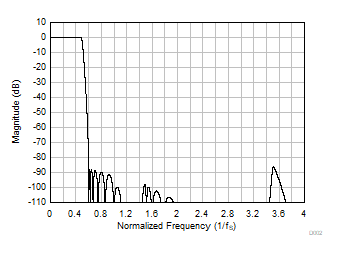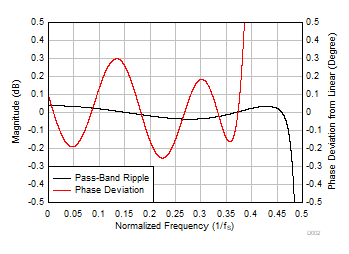SBASA61A December 2020 – June 2021 PCM1820 , PCM1821
PRODUCTION DATA
- 1 Features
- 2 Applications
- 3 Description
- 4 Revision History
- 5 Device Comparison Table
- 6 Pin Configuration and Functions
- 7 Specifications
-
8 Detailed Description
- 8.1 Overview
- 8.2 Functional Block Diagram
- 8.3
Feature Description
- 8.3.1 Hardware Control
- 8.3.2 Audio Serial Interfaces
- 8.3.3 Phase-Locked Loop (PLL) and Clock Generation
- 8.3.4 Input Channel Configurations
- 8.3.5 Reference Voltage
- 8.3.6
Signal-Chain Processing
- 8.3.6.1 Digital High-Pass Filter
- 8.3.6.2
Configurable Digital Decimation Filters
- 8.3.6.2.1
Linear Phase Filters
- 8.3.6.2.1.1 Sampling Rate: 8 kHz or 7.35 kHz
- 8.3.6.2.1.2 Sampling Rate: 16 kHz or 14.7 kHz
- 8.3.6.2.1.3 Sampling Rate: 24 kHz or 22.05 kHz
- 8.3.6.2.1.4 Sampling Rate: 32 kHz or 29.4 kHz
- 8.3.6.2.1.5 Sampling Rate: 48 kHz or 44.1 kHz
- 8.3.6.2.1.6 Sampling Rate: 96 kHz or 88.2 kHz
- 8.3.6.2.1.7 Sampling Rate: 192 kHz or 176.4 kHz
- 8.3.6.2.2 Low-Latency Filters
- 8.3.6.2.1
Linear Phase Filters
- 8.3.7 Dynamic Range Enhancer (DRE)
- 8.4 Device Functional Modes
- 9 Application and Implementation
- 10Power Supply Recommendations
- 11Layout
- 12Device and Documentation Support
- 13Mechanical, Packaging, and Orderable Information
Package Options
Mechanical Data (Package|Pins)
- RTE|20
Thermal pad, mechanical data (Package|Pins)
Orderable Information
8.3.6.2.2.5 Sampling Rate: 96 kHz or 88.2 kHz
Figure 8-29 shows the magnitude response and Figure 8-30 shows the pass-band ripple and phase deviation for a decimation filter with a sampling rate of 96 kHz or 88.2 kHz. Table 8-19 lists the specifications for a decimation filter with a 96-kHz or 88.2-kHz sampling rate.
 Figure 8-29 Low-Latency Decimation Filter Magnitude Response
Figure 8-29 Low-Latency Decimation Filter Magnitude Response Figure 8-30 Low-Latency Decimation Filter Pass-Band Ripple and Phase Deviation
Figure 8-30 Low-Latency Decimation Filter Pass-Band Ripple and Phase DeviationTable 8-19 Low-Latency Decimation Filter
Specifications
| PARAMETER | TEST CONDITIONS | MIN | TYP | MAX | UNIT |
|---|---|---|---|---|---|
| Pass-band ripple | Frequency range is 0 to 0.466 × fS | –0.04 | 0.04 | dB | |
| Stop-band attenuation | Frequency range is 0.6 × fS onwards | 86.3 | dB | ||
| Group delay or latency | Frequency range is 0 to 0.365 × fS | 7.7 | 1/fS | ||
| Group delay deviation | Frequency range is 0 to 0.365 × fS | –0.027 | 0.027 | 1/fS | |
| Phase deviation | Frequency range is 0 to 0.365 × fS | –0.26 | 0.30 | Degrees |